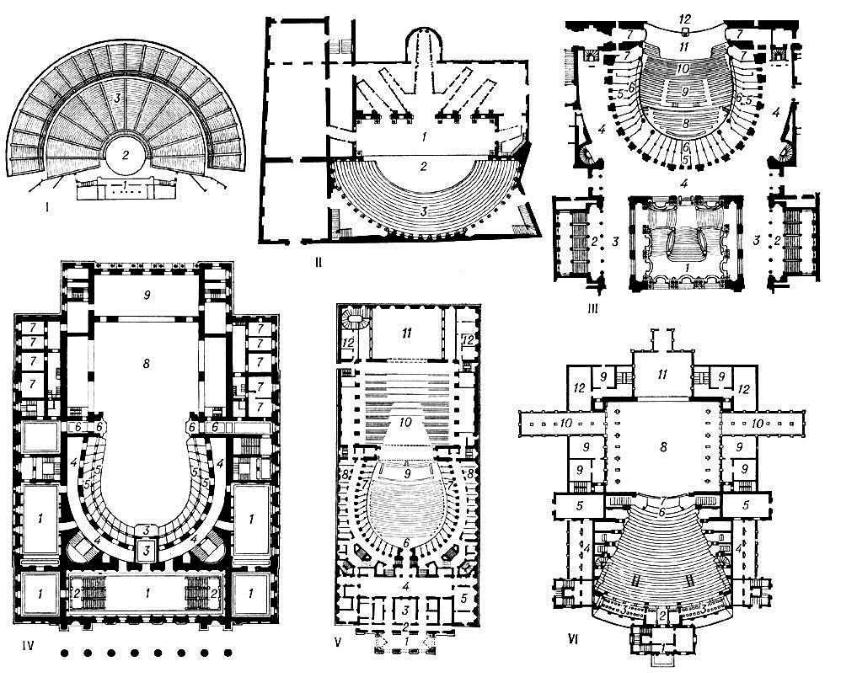
11104
.pdf
General Functional Planning Diagram of Space Links spectator complex:
1 - cash lobby; 2 - entrance lobby; 3, 4 – booth ticket offices and on-duty administrator; 5 - distribution lobby; 6, 7, 8 - dressing rooms; 9 - office of the chief administrator ; 10 - room of ticket distributors; 11 - children's room; 12 - foyer; 13 - pantry; 14 - buffet; 15 - washing, pre-cooking; 16 - warehouse; 17 - exposition room of the museum; 18 - storage facility; 19 - staff room; 20 - sanitary units; 21 - smoking; 22 - auditorium; 23 - club premises;
I - connections; II - linkage variants; III - units; IV - input; V - possible input; VI - possible room (communications)

PYOTR FOMENKO THEATER-WORKSHOP IN MOSCOW, ARM. S.V. GNEDOVSKY, M.M. GAVRILOVA, M.YU. KRYLOV,
I. S. ZAKHAROV, O.B. BARSUKOVA, CONSTR. S.Y. GNEDOVSKY, 2004

Examples of schemes for building a spectator complex:
a - foyer without kuluars; b - foyer with kuluars and organization of entrance to the hall from them; 1 - auditorium; 2 - foyer; 3 - kuluars
Rooms of the demonstration complex
The main goal of the functional and planning solution of the theater can be defined as the creation of a complex of facilities for the perception of the performance by the audience and for the preparation and conduct of it by the creative team.
The capacity of the auditorium is recommended depending on the goal of the theater:
•in the drama theater - 500-800 seats;
•in musical and drama theater - 500-1000 seats;
•in the musical comedy theater - 800-1200 seats;
•in the opera and ballet theater - 1200-1500 seats.
The different capacity of theaters is determined by the design task. The area of the auditorium is accepted at a rate of 0.7 m2 per
place. Auditorium area (including balconies) defined within enclosing structures in front up to the stage, the advance stage or the barrier of the orchestra pit.
In the history of the theater, two main systems of organization have developed: open and deep. The first, coming from Antiquity, unites the audience and theatrical action in the scope of a single hall. At the same time, the audience is located on three sides of the stage. The other, coming from the Renaissance and the Baroque, separates the action on the deep stage from the auditorium with a portal frame. There are searches for various forms of stage display. The transformation technique reveals more possibilities in this direction.
A portal or deep stage
With a deep stage, the performance is at first perceived by the viewer precisely as a performance, the action develops in another environment, in the "other world," separated from the hall.

The main parameter determining the dimensions and shape of the portal stage and the auditorium is the size of the playground. Practice has shown that the active action of dramatic performances takes place on a site from 8 to 14 m wide and from 5 to 10 m deep. For musical theaters with the participation of ballet, the playground should be at least 12 × 12 m. The width of the portal in the drama theater is 10-14 m, in the opera and ballet theater - from 14 to 16 m.
The width of the stage consists of the width of the playing space,
or portal. There are side spaces sufficient to room special devices that decorate the sides of the curtains. There are also volume decorations, places for the actors and the placement of light equipment. Typically, the width of the stage should be at least 2 times the width of the portal hole.
The depth of the stage is usually made 1.5 times the width of the portal. The deep stage is equipped with layers and lifts - devices for quick change of decorations. The height of the stage to the layers is three heights of the portal hole. In addition to the main stage, to speed decoration change of side stages, the lower stage and the rear stage are provided.

Diagram of construction of deep layers stage in plan and in lifts:
1 - smoke valves; 2 - blank platform; 3 - stage bars; 4 - working galleries; 5 - hold; 6 - rotating circle and ring of cutting-in type; 7 - rear stage; 8 - a safe cover for rolling decorations; 9 - stage; 10 – side stage; 11 - advance stage; 12 - opening of the orchestra pit;
Шсц - the width of the stage; Гсц - the depth of the stage; Всц - stage height; Шк - side stage width; Гк - side stage depth; Вк - side stage height;
Шар - rear stage width; Гар - rear stage depth; Шс - construction portal width; Ши - performance portal width; Га – advance stage depth; Шяп - opening orchestra pit width
